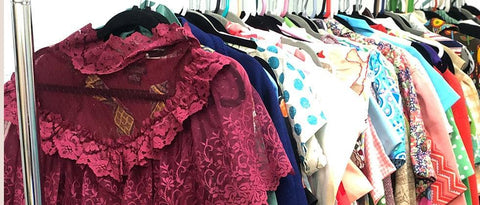Are Thrift stores and Vintage stores Starting to Look Identical?

For the longest time, thrift stores and vintage stores had two completely different business models.
Being a source for vintage clothing, we have seen a shift in the way people bulk buy. A shift that has become more focused on buying a combination of vintage and wholesale thrift clothing, instead of just vintage one. Salvation Army, Goodwill, and Savers are a few names that people associate with thrift stores.
What is the difference between a Thrift store and a Vintage store?

Traditionally there was a distinction in society between a thrift store and a vintage store.
A thrift store used to be defined by the fact that the product was vast and updated daily, sometimes even hourly. Their focus was more about their inventory turnover rather than their margins.
Vintage stores were known for a more curated mix, where prices are definitely substantially higher than a normal thrift store. The focus of a vintage store was primarily on clothing from decades prior to the 90’s.
Today, we are seeing drastic changes in our conventional thrift stores. With the markets shifting towards a more circular economy, along with the current sustainability movement, there has been a switch on what a thrift store looks like.
Let’s have a more detailed view of what significant changes are observed in the thrift stores with respect to Size, Location, and Products.
- Vintage Clothing
- Shift in Location
- Shift in the Products
Shift in Size:
The average thrift store size used to be 10,000 square feet. But with changing times and trends, thrift stores are starting to implement the boutique store model to cut down their store size.
Even big names like thrift stores have scaled down their size significantly and calling their boutique stores ‘Blue Boutique’.
Noteworthy, that the vintage stores on the other hand have increased their store sizes to accommodate the newly created ‘Thrift Sections’.
Shift in Location:
In the past, thrift stores were located in lower income areas. The target markets for such stores usually used to be the working class masses, having a limited budget consumption.
With the introduction of this hybrid thrift vintage store, we are seeing a shift of location towards more middle income and tourist locations.
Shift in the Products:
A traditional thrift store takes the product that they receive from their own consignment avenue, processes their goods in a warehouse type space, and then consistently places new products on the floor. Leftovers from these thrift stores are often baled up and sent to rag houses, recycling clothing companies, like us! The focus of the traditional thrift stores was more on inventory turnover then on profit margins.
However today, thrift stores offer a mix that is curated but definitely more “modern”. The mix concentrates on modern designer labels and popular “vintage” items such as Levi 501 jeans and the Patagonia fleece jackets.

Wasteland is a great example of a curated thrift store. Their stores are filled with designer labels that are often found in Nordstrom and Blooming dales. The Wasteland team also buys back clothing from the public every single day during a window of time.
Are the Vintage Stores changing too?
The above discussed areas have shown us how a traditional thrift store has changed, but simultaneously there has been a shift of what a traditional vintage store looks like too.
Introduction of Per Pound/Per Kilo Model:
We are seeing many Vintage stores creating a “per pound” or “kilo store” model. The items that are not sold in their vintage retail stores are usually sold in these “per pound” or “kilo stores” for a flat rate. For many of our customers this has become a great avenue to move dead stock and move their inventory.
Introduction of Thrift Section in the Vintage Stores:
Another trend that we have seen in the market as a vintage wholesaler, is the addition of new “thrift” section. Vintage stores have been creating this section to their vintage retail locations.
When purchasing bulk thrift clothing from a clothing recycler, these retail locations have an edge, because it increases their purchasing power with a vintage wholesaler.
Vintage wholesalers are more likely to work with retailers if they can take a variety of products, rather than a few high demand items that almost everyone in the vintage community wants.
All in all, It is interesting to see the evolution and the amalgamation of these two retail concepts slowly blur together. We hope to see more of it in the future.
Conclusion:
In the rag trade industry, most rag houses have a second hand clothing department and then a separate vintage clothing section.
With the gap between the two sections blurring, there has been a lot of overlap in both departments. Buying bulk thrift clothing and vintage clothing has become much more difficult as the gap has been diminishing over the years.
As a vintage wholesaler, we have seen a shift towards these boutique type thrift stores and we are excited to see how our industry will continue to evolve over the years.
Want to know more about us? Check out our vintage clothing collections for your everyday Vintage looks. We deliver worldwide!



